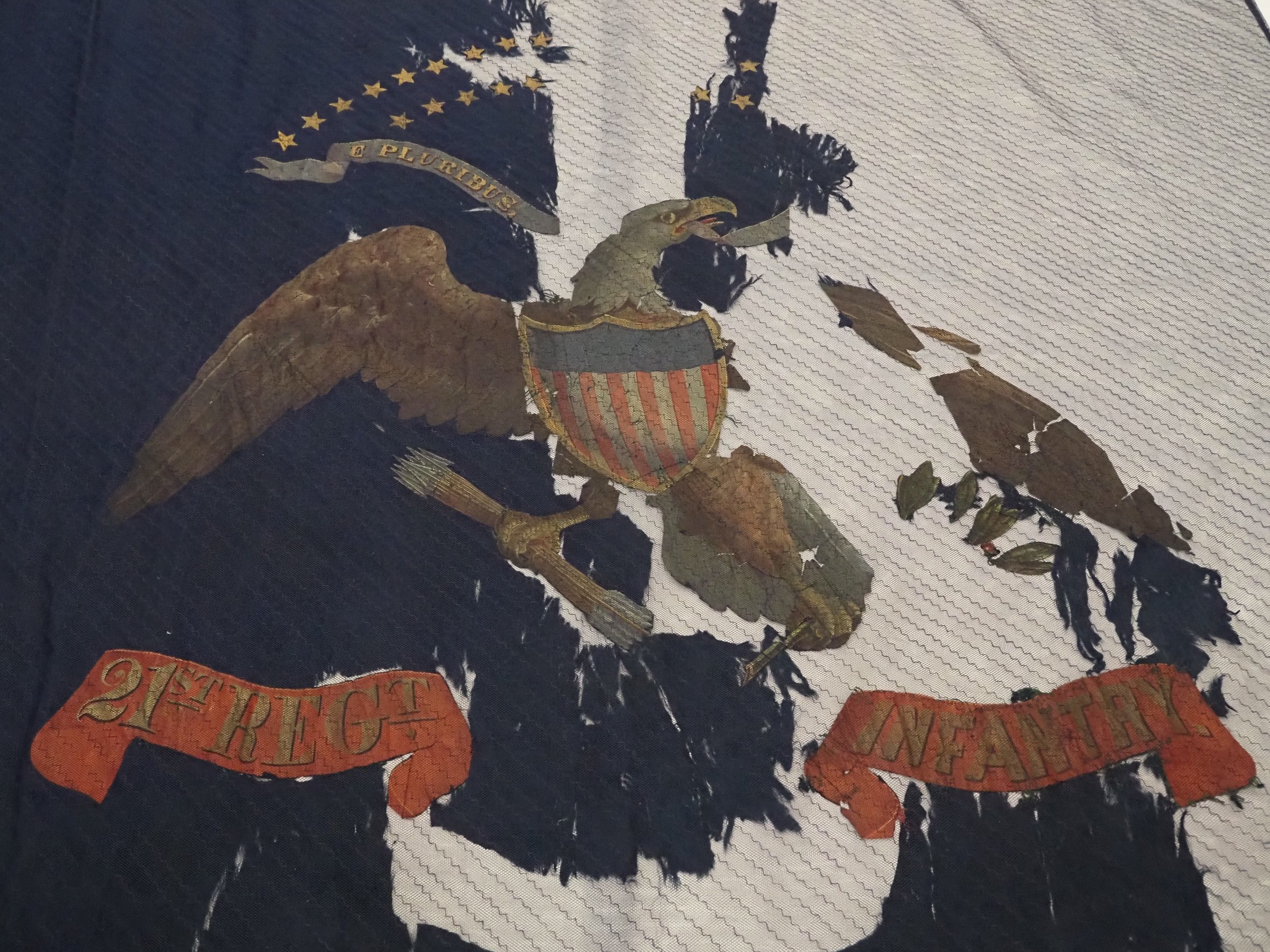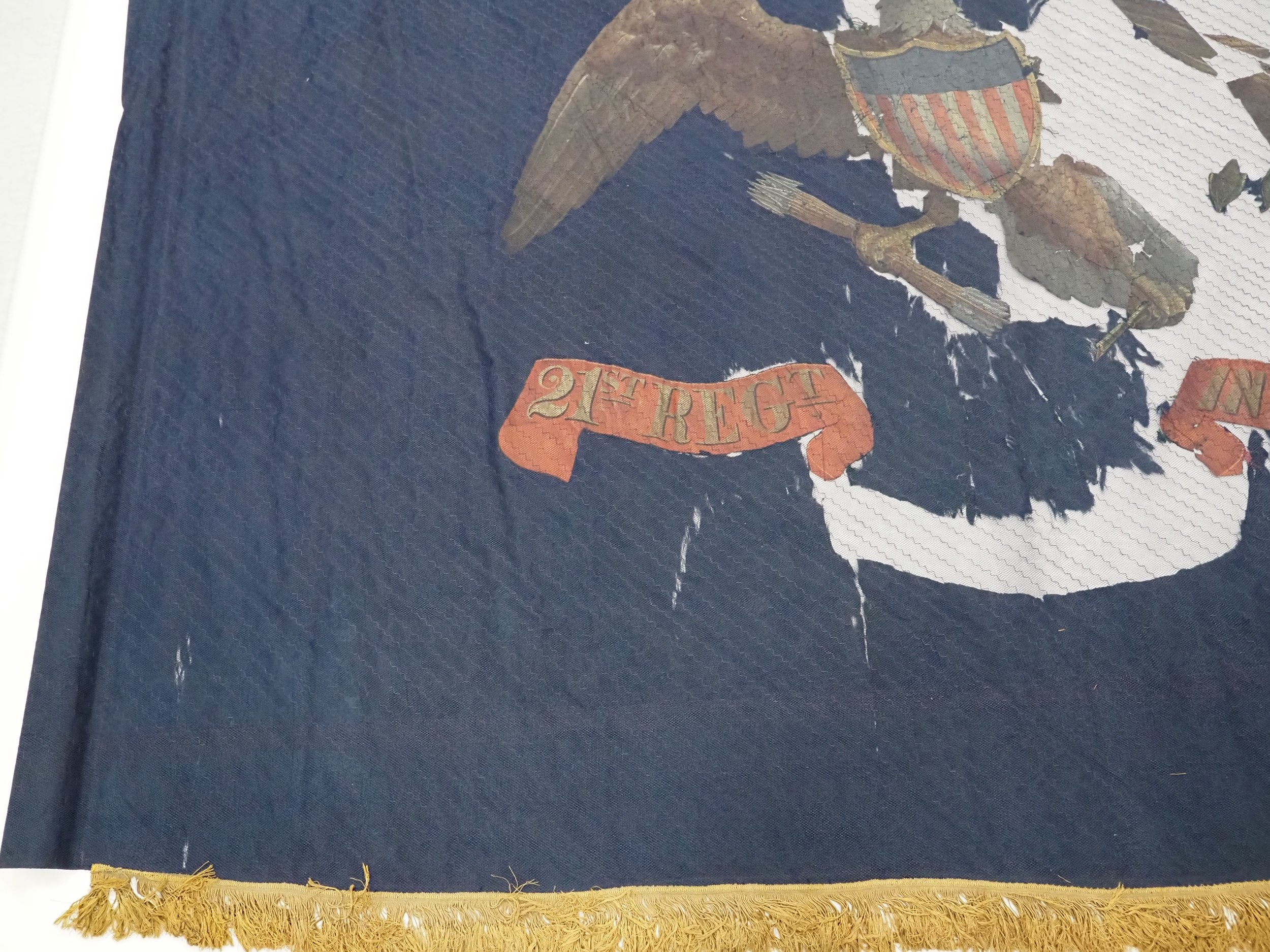



21st Michigan Volunteer Infantry
SC-67-90: Silk national ▪ Dimensions: 71” x 57+”
Description:
Almost nothing remains of this silk national flag with the exception of a few scraps of silk in the canton and red stripes.
The staff, which measures 93.75” by 1.5”, lacks a finial, but has a flange where a finial would have attached. The staffs of flags returned to the state at the 1866 Detroit ceremony marking the end of the war all bear identical brass plaques. The brass plaque reads in Spencerian script “21st Mich. Infantry”.
No tassels or cords remain.
The flag was netted (sewn between layers of dyed net) in the 1960s in an early attempt at conservation.
Adoption:




21st Michigan Volunteer Infantry
SC-68-90: Silk regimental ▪ Dimensions: 72.25” x 75.5” ▪ Fringe
Description:
This silk regimental flag features the federal eagle with two arced rows of stars above. There is a lot of loss in the flag and only seventeen of the original stars remain. A regimental designation is painted below the eagle and only part of that remains as well. What remains reads, “21ST REGT. — INFANTRY.” A gold-colored fringe is attached to the top and bottom of the flag. The hoist end was fashioned into a sleeve for attachment to the staff.
The staff, which measures 93.5” by 1.5”, lacks a finial, but has a flange where a finial would have attached. The staffs of flags returned to the state at the 1866 Detroit ceremony marking the end of the war all bear identical brass plaques. The brass plaque reads in Spencerian script “21st Mich. Infantry”.
No tassels or cords remain.
The flag was netted (sewn between layers of dyed net) in the 1960s in an early attempt at conservation.
Adoption:





21st Michigan Volunteer Infantry
SC-69-90: Silk national ▪ Dimensions: 79.5” x 75.5” ▪ Fringe
Description:
This 35-star silk national flag has gold painted stars arranged in five rows of seven stars. The flag is painted with a regimental designation and battle honors. The regimental designation arcs over the first white stripe and second red stripe over the painting of a rising sun. It reads “21ST. MICH. VOL. INFT.” Battle honors are painted starting on the second white stripe and read, in order, “PERRYVILLE,” “STONE RIVER,” “CHICKAMAUGA,” “BROWN’S FERRY,” “CHATTANOOGA,” “SAVANNAH,” “AVERYSBORO,” “BENTONVILLE,”. There are many splits in the silk. A gold-colored fringe is attached to the top, bottom, and fly edge of the flag. The hoist end was fashioned into a sleeve for attachment to the staff.
The staff, which measures 87” by 1.25”, is topped by a spade-shaped finial. The staffs of flags returned to the state at the 1866 Detroit ceremony marking the end of the war all bear identical brass plaques. The brass plaque reads in Spencerian script “21st Mich. Infantry”.
The flag has a 150” blue and white twisted silk cord with two blue and white tassels measuring 1.5” in diameter. The tassels were formed over a wooden core. The cord has some staining and one of the tassels has started to unravel.
The flag was netted (sewn between layers of dyed net) in the 1960s in an early attempt at conservation.
Adoption:
October 25, 1997 - Barry County Historical Society

21st Michigan Volunteer Infantry
SC-70-90: Wool national ▪ Dimensions: 71.5” x 71.5”
Description:
This 34-star wool national flag has cotton applique stars sewn on the canton. Wool flags are unique in our Civil War flag collection. The flag is mostly intact but there are several splits and a piece in the bottom corner of the fly end is almost entirely detached. The hoist end was fashioned into a sleeve for attachment to the staff.
The staff, which measures 87.25” by 1.25”, is topped by a spear finial with a metal crosspiece. The staffs of flags returned to the state at the 1866 Detroit ceremony marking the end of the war all bear identical brass plaques. The brass plaque reads in Spencerian script “21st Mich. Infantry”.
The flag has a 129” blue and white twisted silk cord with a blue and white tassel measuring 1.5” in diameter. The tassel was formed over a wooden core. Originally there was a second tassel, but it is missing.
The flag was netted (sewn between layers of dyed net) in the 1960s in an early attempt at conservation. During this process, the flag was divided into three so that blue net could be sewn over the canton and red and white over the stripes and the seam creating the pole sleeve was taken apart. The net was sewn on with machine stitching in a zig-zag pattern. With the passage of time, the 1960s netting is deteriorating and degrading and there is a risk of it becoming embedded into the original flag material. In 2022, conservation specialists at the Michigan State Capitol carefully cut each stitch of the previous treatment, removing it with tweezers so the net could be gently removed. The flag was then surface cleaned with a museum grade vacuum. The pole sleeve, which had been unstitched during the 1960’s conservation, was humidified to remove wrinkles. Also, the canton, which was starting to fray at the top, was encapsulated between layers of fine nylon tulle.
Adoption:
